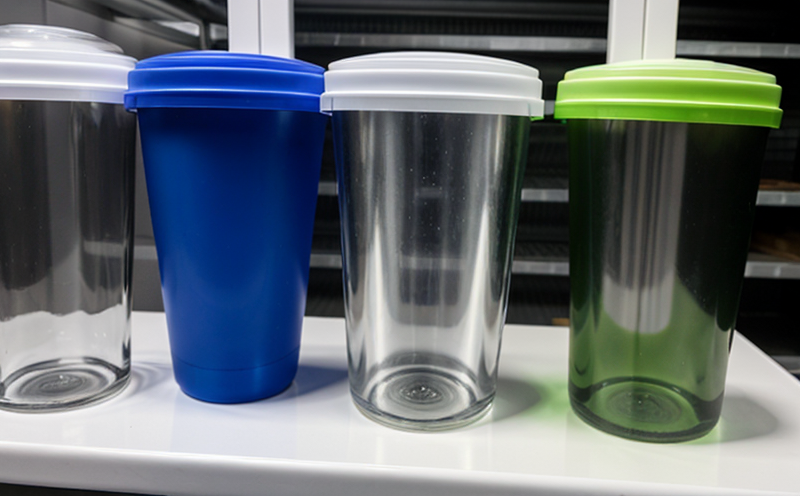ASTM E438-07 Thermal Shock Simulation
The ASTM E438-07 standard test method is a crucial procedure in glass packaging testing, designed to evaluate the thermal shock resistance of glass containers and closures. This test simulates extreme temperature changes that a container might encounter during transportation or storage conditions. The primary objective is to ensure that glass packaging can withstand such shocks without cracking, leaking, or otherwise failing.
The ASTM E438-07 Thermal Shock Simulation involves subjecting specimens to rapid changes in temperature using alternating cycles of hot and cold water baths. This method helps identify potential weaknesses in the design and manufacturing process of glass containers. The test is particularly relevant for industries such as pharmaceuticals, food & beverage, and cosmetics, where product integrity and safety are paramount.
The testing procedure is conducted under controlled conditions to simulate real-world scenarios. Specimens undergo a series of temperature cycling between hot and cold baths at specified rates and durations. The thermal shock resistance is evaluated based on the ability of the glass to withstand these extreme conditions without sustaining damage or compromising its structural integrity.
The ASTM E438-07 test protocol provides detailed guidelines for specimen preparation, test setup, temperature cycling parameters, and observation criteria. Specimens are typically prepared by selecting representative samples from production batches or specific runs. The specimens must be free of any defects that could influence the test results.
The test apparatus consists of a thermal shock testing chamber capable of maintaining precise temperature control within specified ranges. This equipment is essential for ensuring accurate and reliable test results. The chamber is equipped with hot and cold water baths, which are used to cycle the specimens through defined temperature ranges. The rate at which the temperature changes between cycles is critical, as it directly influences the stress experienced by the glass.
The acceptance criteria for ASTM E438-07 are stringent, focusing on the structural integrity and functionality of the glass container throughout the test cycles. Specimens that fail to meet these criteria are considered unsuitable for use in demanding applications such as pharmaceutical packaging or food containers. Compliance with international standards like ASTM E438-07 is essential for manufacturers seeking to ensure product quality and safety.
For R&D engineers, the ASTM E438-07 Thermal Shock Simulation offers a valuable tool for optimizing glass container designs. By subjecting specimens to controlled temperature cycles, engineers can identify areas of improvement in material selection or manufacturing processes. This information is invaluable for enhancing product durability and performance.
Quality managers and compliance officers benefit from ASTM E438-07 by ensuring that products meet rigorous industry standards. The test results provide a quantitative measure of thermal shock resistance, which can be used to demonstrate compliance with regulatory requirements. For procurement teams, this service supports the selection of high-quality suppliers who adhere to stringent testing protocols.
Why Choose This Test
- Ensures product integrity and safety in extreme temperature conditions.
- Identifies potential weaknesses in glass container design and manufacturing processes.
- Complies with international standards, enhancing marketability and regulatory compliance.
- Supports R&D efforts to optimize glass container performance and durability.
- Provides quantitative data on thermal shock resistance for informed decision-making.
International Acceptance and Recognition
The ASTM E438-07 Thermal Shock Simulation is widely recognized in the packaging industry as a robust method for evaluating glass container performance. Its acceptance by regulatory bodies around the world ensures that test results are credible and universally applicable. Compliance with this standard demonstrates a commitment to quality and safety, which is essential for maintaining market access and consumer trust.
The international nature of ASTM E438-07 makes it particularly valuable for global companies operating in diverse markets. By adhering to this standard, manufacturers can ensure that their products meet the specific requirements of different regions without the need for additional testing or certification processes.
Many countries and industries have adopted ASTM E438-07 as a benchmark for thermal shock resistance tests on glass containers. This widespread acceptance highlights its relevance and reliability in various packaging applications, from pharmaceuticals to consumer goods.
Environmental and Sustainability Contributions
The ASTM E438-07 Thermal Shock Simulation plays a significant role in promoting environmental sustainability by ensuring that glass containers are robust and reliable. By identifying potential weaknesses early in the design process, this test helps prevent waste and reduce material usage. This contributes to a more sustainable packaging industry.
Through rigorous testing, ASTM E438-07 supports the development of eco-friendly products that can withstand harsh environmental conditions without compromising quality. This aligns with broader sustainability goals in the manufacturing sector, promoting circular economy principles and reducing waste generation.
The test also encourages continuous improvement in glass container design, leading to more durable and efficient packaging solutions. This not only benefits manufacturers but also contributes to a more sustainable supply chain by ensuring that products are resilient against environmental challenges.





